TURING CHURCH TIMELINE
1957: Turing Church founder Giulio Prisco was born in Naples, Italy.
1998: The World Transhumanist Association was founded.
2002: Prisco joined the Board of Directors of the World Transhumanist Association.
2004: The Institute for Ethics and Emerging Technologies was founded, with Prisco serving on the Board of Directors.
2008 (June 14): The first meeting of The Order of Cosmic Engineers was held at Silvermoon city in the online game World of Warcraft.
2008 (July 20): The second meeting of the Order of Cosmic Engineers was held at the Terasem Amphitheater in Second Life.
2009: Prisco collaborated with Ben Goertzel in developing Ten Cosmist Convictions.
2010 (October 1): Prisco gave a presentation about the Turing Church at the Transhumanism and Spirituality Conference.
2010 (November 20): The Turing Church Online Workshop 1 was held.
2011: Turing Church Facebook group was founded.
2012 (April 6): Prisco presented the Turing Church at the conference of the Mormon Transhumanist Association.
2013: Prisco contributed a chapter to The Transhumanist Reader.
2018: Prisco’s book, Tales of the Turing Church, was published.
FOUNDER/GROUP HISTORY
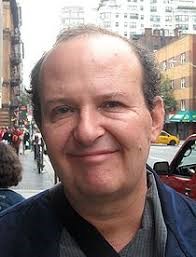
Born in Naples, Italy, in 1957, Giulio Prisco [Image at right] studied physics and computer science, held a management position in the European Space Agency, then became an independent consultant about information technology, with an emphasis on virtual reality and live streaming systems. Early in its history, he became active in the worldwide Transhumanist Movement, often playing leadership or advisory roles.
The Turing Church can be seen as a branch of the Transhumanist Movement, or as one of its successors. Over the years, a diversity of scientists, engineers, and intellectuals have contributed to a general social movement that imagines technology could transform the human species into something greater, more advanced, cosmic, and even immortal. The seed that planted this movement was the 1989 book Are You a Transhuman? by FM-2030. The author was originally named Fereidoun M. Esfandiary but in a quasi-religious self-transformation had adopted the name FM-2030 to render himself technological and oriented toward the future, as suggested by the year 2030. Following standard definitions he died in the year 2000, yet in Transhumanist theory may still live, because his brain has been archived at Alcor Life Extension Foundation, which was founded in 1972 with the goal of using cryonics (freezing) or other technological means to preserve otherwise deceased humans until medical science can cure their fatal illnesses and restore them to life. In 2011, on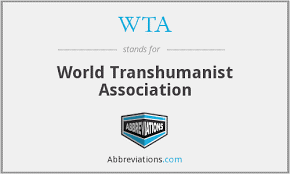 of FM-2030’s disciples, Max More, became director of Alcor.
of FM-2030’s disciples, Max More, became director of Alcor.
The organizational history of Transhumanism is complex, but notably in 1998 the World Transhumanist Association was founded, [Image at right] and held annual meetings in Netherlands, Sweden, England, German, the United States, Canada, Venezuela, and Finland. For a time, Prisco served on its board of directors. In 2004, the Institute for Ethics and Emerging Technologies was founded, with a somewhat different mission as indicated by its name, and Prisco was a member of its board of directors. In 2008, the evolving World 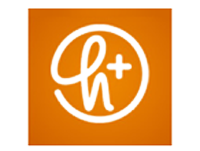 Transhumanist Association adopted a new name, Humanity Plus or Humanity+, [Image at right] and Natasha Vita-More became its director. She and Max More had been leading disciples of FM-2030, like him having adjusted their names to stress a focus on the future. In 2013, they edited the anthology, The Transhumanist Reader, which includes a chapter by Prisco.
Transhumanist Association adopted a new name, Humanity Plus or Humanity+, [Image at right] and Natasha Vita-More became its director. She and Max More had been leading disciples of FM-2030, like him having adjusted their names to stress a focus on the future. In 2013, they edited the anthology, The Transhumanist Reader, which includes a chapter by Prisco.
The immediate precursor of the Turing Church was The Order of Cosmic Engineers, in which Prisco played a leading role, that launched in 2008 and was effectively succeeded by the Turing Church two years later. He chose Second Life as the venue to announce the Order, in a virtual conference, The Future of Religions/Religions of the Future, on June 4 and 5, 2008 (Bainbridge 2017:224-30). In its Prospectus document, the Order called itself “the world’s first UNreligion” which it defined thus:
When it comes to being an unreligion, this is key: we do not, and do not want to, believe anything on faith. Instead, true to the genuine core of scientific spirit, we want to find out… and true to the core of engineering spirit, we want to also build and create.” In a 2008 blog, Prisco debated the meaning of the term religion: “if religion is defined as ‘seeking to find transcendence and truth, meaning and purpose’, then I am ready and willing to accept the label ‘religious’. I want to find meaning and transcendence through scientific means and, if I don’t find it, I want to build it.
The Order of Cosmic Engineers made heavy use of online virtual worlds, and held its first large-scale meeting June 14, 2008, at Silvermoon in the online game World of Warcraft. That location is the futuristic city belonging to the Horde faction, so each participant was represented by a Horde avatar. The Order’s second meeting was hosted on July 20 of that year by Martine Rothblatt, a leader in the biopharmaceutical industry and advocate for transgender rights, who created a Transhumanist organization named Terasem. Over the years, many meetings involving the Turing Church were held at the Terasem facility in the non-game virtual world, Second Life.
Citing publications dated just before the emergence of the Turing Church, professor of religious studies Robert M. Geraci (2010:86) reported: “Thanks to rapidly advancing technology, Prisco believes that transhumanist promises of immortality and the resurrection of the dead will soon compete with institutionalized religions while shedding the baggage of bigotry and violence that he believes such religions carry.” As early as 2004, Prisco had been blogging about “engineering transcendence”, and in 2011 published an article title “Transcendent Engineering” in the Terasem Journal of Personal Cyberconsciousness. When he spoke in 2012 at a conference of the Mormon Transhumanist Association, he expanded upon but remained faithful to his 2004 statement.
Perhaps the first full public announcement of the Turing Church, or the equivalent of the Sermon on the Mount, was a presentation Prisco made via a desktop video conference system from Italy to the Utah meeting, Transhumanism and Spirituality, October 1, 2010. His title was “The Cosmic Visions of the Turing Church,” which his abstract says “will be a meta-religion, without central doctrine, characterized by common interest in the promised land where science and religion meet, science becomes religion, and religion becomes science.” He quoted two fundamental principles that had been enunciated by fiction writers and that might bridge between the natural and the supernatural: (1) “Any sufficiently advanced technology is indistinguishable from magic. – Sir Arthur C. Clarke’s Third Law.” (2) “There are more things in heaven and earth, Horatio, than are dreamt of in your philosophy. – William Shakespeare, Hamlet.”
Among the very large number and diversity of blogs and other items posted online by Prisco over the years, especially meaningful is his March 23, 2012, non-obituary about his friend and colleague Fred Chamberlain, who with his wife Linda had founded Alcor. Titled, “Good bye, Fred, see you soon,” it began with the news that Fred just “had his brain placed into cryostasis at the Alcor Life Extension Foundation in Scottsdale.” In full agreement, he quoted Linda’s proclamation: “His physical presence will be missed by many friends, biological family and chosen family until technology allows a future instantiation to be with us once again.” Quite apart from that hope, the blog links the reader to a series of Terasem-related podcasts Fred and Linda had done earlier that year, thus strengthening a different form of immortality for Fred, the awareness of a wider public about his thoughts and accomplishments.
DOCTRINES/BELIEFS
Its Facebook group explains: “Turing Church is a working group at the intersection of science and religion. Hacking religion, enlightening science, awakening technology.” Rather than having a fixed set of beliefs, the Turing Church is an exploration of possibilities. Its website summarized its hopes:
We will go to the stars and find Gods, build Gods, become Gods, and resurrect the dead from the past with advanced science, space-time engineering and ‘time magic.’ God is emerging from the community of advanced forms of life and civilizations in the universe, and able to influence space-time events anywhere, anytime, including here and now. God elevates love and compassion to the status of fundamental forces, key drivers for the evolution of the universe.
This dynamic perspective places God in the future, rather than the past. It consolidated in 2009 when Prisco collaborated with Ben Goertzel, an innovator in robotics and artificial intelligence, in developing Ten Cosmist Convictions.
Comparable to the Ten Commandments, but presented as ten predictions, the Convictions have the quality of hopes and goals. The first four of them concern near-term development directly related to the activities of the Turing Church: (1) Humans will merge with technology, to a rapidly increasing extent. (2) We will develop sentient AI and mind uploading technology. (3) We will spread to the stars and roam the universe. (4) We will develop interoperable synthetic realities (virtual worlds) able to support sentience.
Prisco has drawn upon the work of many earlier scientists and philosophers, and his book Tales of the Turing Church mentions three worthy of consideration here. The founder of the Turing Church has a Roman Catholic cultural background, and saw a strong connection between the philosophy of paleontologist and Jesuit priest, Pierre Teilhard de Chardin, with spiritually-oriented Transhumanism. For example, in Revelation 1:8, the Bible quotes God: “I am Alpha and Omega, the beginning and the ending, saith the Lord, which is, and which was, and which is to come, the Almighty.” Teilhard de Chardin (1964) postulated a time far in the future, the “omega point,” when God and Humanity would converge. Science has raised questions about whether God actually served the Alpha function of creating the universe, but Prisco suggests that an emergent God may serve the Omega function, if we are able to locate or create the deity.
The second notable cultural connection is the name, Turing Church. It 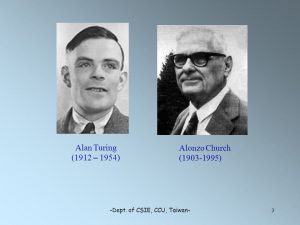 derives from the Church-Turing thesis, a standard principle in mathematics and computer science, developed by two mathematicians, Alonzo Church and Alan Turing. [Image at right] The thesis concerns the general principle of deriving results through a series of rigorously defined transformative steps, such as the procedures in a computer program. In the religious context, the Church-Turing thesis suggests that if God does not exist, the only way to create God is through a series of rigorous scientific discoveries and engineering inventions, perhaps primarily inside computers. This seems to deny the possibility of true transcendence of material reality, and it must be noted that current research in quantum computing may escape the Church-Turing thesis, although we cannot yet be certain about any such rediscovery of transcendence.
derives from the Church-Turing thesis, a standard principle in mathematics and computer science, developed by two mathematicians, Alonzo Church and Alan Turing. [Image at right] The thesis concerns the general principle of deriving results through a series of rigorously defined transformative steps, such as the procedures in a computer program. In the religious context, the Church-Turing thesis suggests that if God does not exist, the only way to create God is through a series of rigorous scientific discoveries and engineering inventions, perhaps primarily inside computers. This seems to deny the possibility of true transcendence of material reality, and it must be noted that current research in quantum computing may escape the Church-Turing thesis, although we cannot yet be certain about any such rediscovery of transcendence.
The third cultural influence, which Prisco connects to the Russian Cosmist movement to develop spaceflight, has developed into a general movement seeking technological transcendence, requiring colonization of the galaxy and development of biological or computational means for achieving immortality.
RITUALS/PRACTICES
Rather than holding worship services inside a physical church, concentrating true believers in one physical location, the Turing Church intentionally reaches out to other comparable groups, holding online meetings to discuss topics of mutual interest, and forming wide communication networks. Rather than expecting each member to engage regularly in standard religious rituals, such as prayer, individuals are encouraged to explore new intellectual, spiritual, and above all scientific experiences. Thus, the Turing Church is in many ways the opposite of a traditional faith, stressing exploration instead of tradition, innovation rather than revival. As with conventional religions, communion is important, but based on shared visions rather than convictions.
For example, the first Turing Church Online Workshop was held for four hours, November 20, 2010, in the Teleplace online virtual environment. The structure was in two parts, formal presentations by five members of a panel, similar to a session at an academic conference, followed by free-form discussion including the audience. Prisco presented the main principles of the Turing Church, and Ben Goertzel spoke about their Cosmist Manifesto. Three others presented the perspectives of organizations in which Prisco was also active: Lincoln Cannon (Mormon Transhumanist Association), Mike Perry (Society for Universal Immortalism) and Martine Rothblatt (Terasem). The Turing Church Online Workshop 2 was held on Sunday, December 11, 2011, with the original five formal panelists plus eight others. The Turing Church has no equivalent of the Bible, but full videos of both workshops were made available to the general public at the archived original website (turning church.com website n.d.) which connects from the subsequent website (turing church.net website n.d.).
The Facebook group devoted to the Turing Church, which had 860 members at the beginning of August 2019, shares news, discussions, and often statements of personal beliefs even sometimes presented as additional new religions. For example, on August 2, admin Lincoln Cohen posted a link to a new BBC article about the future of religion that mentioned the Turing Church. Back on July 16, Prisco had posted a link to a blog on the church’s website, beginning “I am privately celebrating the 50th anniversary of Apollo 11 with bittersweet feelings, but also great expectations and transcendent hope.” That month a member who had been active in the Transcendental Meditation movement and only very recently joined the Turing Church posted a link to “my experiment in trans-human Christianity,” the Yogic Church. A frequent poster on the topic of machine assisted telepathy linked to a presentation he had given at the Parapsychological Convention in Paris.
ORGANIZATION/LEADERSHIP
Turning Church is a virtual organization existing almost entirely online, 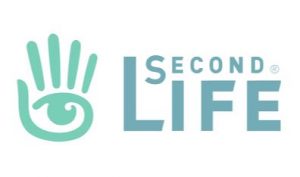 as a series of dynamic conversations often preserved as videos, occasionally held in the Second Life virtual world, [Image at right] and often conducted in video conferencing systems. As of August 1, 2019, the website for the Turing Church had three “editors,” Prisco and two men whose descriptions express both similarity and diversity: “Lincoln Cannon is a technologist and philosopher, and leading advocate of technological evolution and postsecular religion.” “Micah Redding – Christian Transhumanism: Faith & science, religion & technology, the future of humanity. Host of the Christian Transhumanist Podcast.” This trio are also “admins” of the Turing Church Facebook group, along with Nupur Munshi, a freelance research writer in India, and Kathy Wilson, an artist and researcher on spiritual experiences in Utah. It is noteworthy that leaders in the Turing Church are not bishops but editors and admins, in accordance with post-modern Internet culture.
as a series of dynamic conversations often preserved as videos, occasionally held in the Second Life virtual world, [Image at right] and often conducted in video conferencing systems. As of August 1, 2019, the website for the Turing Church had three “editors,” Prisco and two men whose descriptions express both similarity and diversity: “Lincoln Cannon is a technologist and philosopher, and leading advocate of technological evolution and postsecular religion.” “Micah Redding – Christian Transhumanism: Faith & science, religion & technology, the future of humanity. Host of the Christian Transhumanist Podcast.” This trio are also “admins” of the Turing Church Facebook group, along with Nupur Munshi, a freelance research writer in India, and Kathy Wilson, an artist and researcher on spiritual experiences in Utah. It is noteworthy that leaders in the Turing Church are not bishops but editors and admins, in accordance with post-modern Internet culture.
ISSUES/CHALLENGES
Prisco’s October 1, 2010, announcement of the Turing Church ended with a computer simulation of the challenge of resurrecting people by means of data about them archived during life, but it may also simulate the future of the Turing Church itself. The simulation software was a version of the Game of Life, a “cellular automaton” invented by mathematician John Conway and publicized in 1970 in a Scientific American article by Martin Gardner, who often wrote about quasi-religious topics. A matrix of thousands of squares, arranged like a chessboard, is displayed on a computer screen. Some squares are marked, a different set for each simulation. In a series of steps, a set of algorithms, removes and adds marks, for example every black square adjacent to exactly three marked squares becomes marked in the next turn, and every marked square with three or more marked neighbors becomes unmarked. In Prisco’s version, a large set of squares near the middle is marked in the shape of a spaceship, while squares a distance from it are marked at random. Prisco starts the simulation, the spaceship begins to fly, then it disintegrates as it runs into areas of randomly marked squares. In his demonstration, Prisco solved the problem by copying the spaceship a few times into a blank matrix, separating the images from each other. These multiple spaceships flew safely in parallel, with nothing to disrupt their exploration until they reached the edge of the universe.
In its original meaning, the computer simulation illustrated the difficulty of preserving a large, complex system of information, such as a human mind. The Turing Church and related groups have frequently debated which current technology could best preserve the personality and memories of a person after death, in a manner suitable for resurrection by some plausible future technology. Several Transhumanists, including the Terasem group, have proposed capturing data about the person in a computer database, whether through questionnaires, observation of behavior, or some other electronic means throughout the course of life. However, such methods seem either too costly in effort by the person being preserved, or too imprecise. The cryonic method of freezing the brain requires modest effort by professionals at Alcor, but none by the “deceased” person, except perhaps paying for the cost of multi-decade preservation. However, as has often been debated in meetings at which Prisco participated, freezing or alternate vitrification methods may destroy the tiny structures in the brain that represent the mind. So, one challenge for the Turing Church is the problem that a technology for preservation and reanimation of the human mind may not exist for many years, if ever, offering no hope of immortality for people who are alive today.
The organizations that comprise the general Transhumanist Movement are nearly all operated by very small teams or even just individuals, although they have many “followers” in the Internet sense of the term. That implies that they may not survive their leaders. Currently, the thinking and modes of expression of Giulio Prisco are very well documented in hundreds of online videos and writings, but dispersed across a number of platforms, any of which might vanish tomorrow. The Turing Church has not built a temple, let alone a giant cathedral, and durable paper versions of its scriptures are rare. So, one challenge for the Turing Church and other “unreligions” is to develop durable archives, perhaps like the Web archive called The Wayback Machine, but also involving physical records capable of lasting centuries.
Prisco’s 2010 simulation takes on greater meaning a decade later, as the stability of the New World Order comes increasingly into question, and a government-supported Artificial Intelligence frenzy attaches very different meanings to core concepts of the Turing Church. That is to say that the cultural environment around the Turing Church has become more chaotic, potentially causing many people to seek stability in their lives, which might favor traditional religions rather than religious innovation. Generally absent in Transhumanism is the personal, emotional support provided by clergy in religious societies, and psychotherapists in secular societies. Whether the equivalent of local clergy could develop within the Turing Church remains to be seen.
REFERENCES
Bainbridge, William Sims. 2017. Dynamic Secularization. Cham, Switzerland: Springer.
FM-2030. 1989. Are You a Transhuman? New York: Warner.
Gardner, Martin. 1970. “The Fantastic Combinations of John Conway’s New Solitaire Game ‘Life,’” Scientific American 223 (October):120-23.
Geraci, Robert M. 2010. Apocalyptic AI: Visions of Heaven in Robotics, Artificial Intelligence and Virtual Reality. New York: Oxford University Press.
Goertzel, Ben. 2010. A Cosmist Manifesto: Practical Philosophy for the Posthuman Age. Humanity+ Press.
More, Max, and Natasha Vita-More. 2013. The Transhumanist Reader: Classical and Contemporary Essays on the Science, Technology, and Philosophy of the Human Future. New York: Wiley-Blackwell.
Prisco, Giulio. 2018. Tales of the Turing Church. Turing Church.
Prisco, Giulio. 2011. “Transcendent Engineering,” The Journal of Personal Cyberconsciousness 6(2). Accessed from http://www.terasemjournals.com/PCJournal/PC0602/prisco.html on 5 August 2019.
Teilhard de Chardin, Pierre. 1964. The Future of Man. New York: Harper.
Turing Church website (new). n.d. Accessed from https://turingchurch.net/ on 3 August 2019.
Turing Church website (original). n.d. Accessed from turingchurch.com on 3 August 2019.
Publication Date:
6 August 2019
